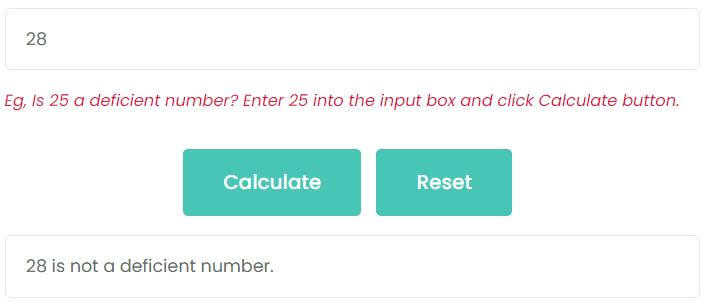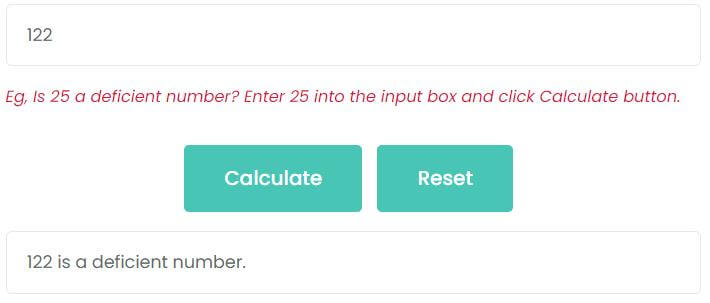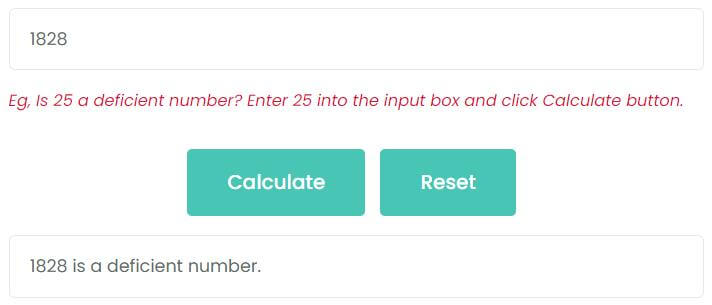Welcome to use the Deficient Number Calculator, which can help you quickly verify whether the number is a deficient number.
What's the deficient number?
The deficient number is the opposite of the abundant number. When the sum of all proper factors of a positive integer is less than itself, then the positive integer can be called a deficient number. Neither perfect numbers nor semi-perfect numbers are deficient numbers.
For example: Is 15 a deficient number?
The proper factors of 15 are 1, 3, 5. Their sum is 1 + 3 + 5 = 9.
9 < 15. So, 15 is a deficient number.
Deficient numbers between 1 and 100 are:
- 1
- 2
- 3
- 4
- 5
- 7
- 8
- 9
- 10
- 11
- 13
- 14
- 15
- 16
- 17
- 19
- 21
- 22
- 23
- 25
- 26
- 27
- 29
- 31
- 32
- 33
- 34
- 35
- 37
- 38
- 39
- 41
- 43
- 44
- 45
- 46
- 47
- 49
- 50
- 51
- 52
- 53
- 55
- 57
- 58
- 59
- 61
- 62
- 63
- 64
- 65
- 67
- 68
- 69
- 71
- 73
- 74
- 75
- 76
- 77
- 79
- 81
- 82
- 83
- 85
- 86
- 87
- 89
- 91
- 92
- 93
- 94
- 95
- 97
- 98
- 99
How to use the deficient number calculator
The procedure to use the deficient number calculator is as follows:
- Enter the positive number.
- Click Calculate button to verify whether the input number is a deficient number.
- Click the Reset button to start a new verification.
Solved examples using the deficient number calculator
Example 1: Is 28 a deficient number?
Enter 28 into the input box and click Calculate button, as shown in the figure, 28 is not a deficient number.
The sum of all proper factors of 28 is:
1 + 2 + 4 + 7 + 14 = 28

Example 2: Is 122 a deficient number?
Enter 122 into the input box and click Calculate button, as shown in the figure, 122 is a deficient number.
The sum of all proper factors of 122 is:
1 + 2 + 61 = 64 < 122

Example 3: Is 1828 a deficient number?
Enter 1828 into the input box and click Calculate button, as shown in the figure, 1828 is a deficient number.
The sum of all proper factors of 1828 is:
1 + 2 + 4 + 457 + 914 = 1378 < 1828

Latest calculators
Standard Form to Slope-Intercept Form Calculator
Slope Intercept Form Calculator
Slope Calculator: Calculate Slope, X-Intercept, Y-Intercept
Reciprocal of Complex Number Calculator
Conjugate Complex Number Calculator
Modulus of Complex Number Calculator
Profit Percentage Calculator: Calculate Your Profitability Easily
Attendance and Absence Percentage Calculator
Circular Segment Radius Calculator
Regular Polygon Side Length Calculator
Annulus Calculator for Width, Perimeter, and Area